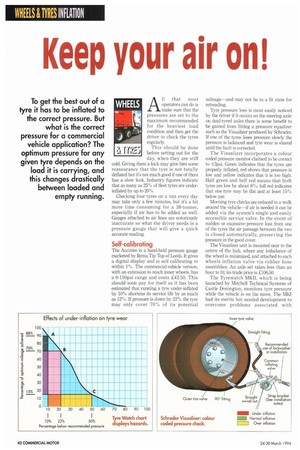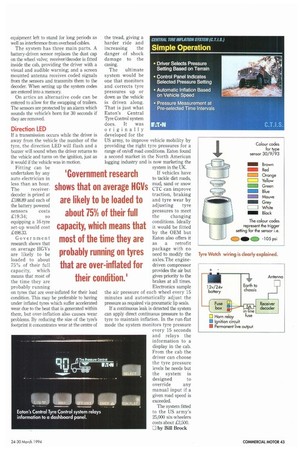Keep your air on!
Page 46

Page 47

If you've noticed an error in this article please click here to report it so we can fix it.
To get the best out of a tyre it has to be inflated to the correct pressure. But what is the correct pressure for a commercial vehicle application? The optimum pressure for any given tyre depends on the load it is carrying, and this changes drastically between loaded and empty running.
All that most operators can do is make sure that the pressures are set to the maximum recommended for the heaviest load condition and then get the driver to check the tyres regularly.
This should be done before setting out for the day, when they are still cold. Giving them a kick may give him some reassurance that the tyre is not totally deflated but it's not much good if one of them has a slow leak. Industry figures indicate that as many as 25% of fleet tyres are underinflated by up to 20%.
Checking four tyres on a van every day may take only a few minutes, but it's a bit more time consuming for a 38-tonner, especially if air has to be added as well. Gauges attached to air lines are notoriously inaccurate so what the driver needs is a pressure gauge that will give a quick accurate reading.
Self-calibrating
The Accutire is a hand-held pressure gauge marketed by Rema Tip Top of Leeds. It gives a digital display and is self calibrating to within 1%. The commercial-vehicle version, with an extension to reach inner wheels, has a 0-150psi range and costs £42.50. This should soon pay for itself as it has been estimated that running a tyre under-inflated by 10% shortens its service life by as much as 12%. If pressure is down by 22% the tyre may only cover 70% of its potential mileage—and may not be in a fit state for retreading.
Tyre pressure loss is most easily noticed by the driver if it occurs on the steering axle: on dual-tyred axles there is some benefit to be gained from fitting a pressure equalizer such as the Visualizer produced by Schrader. If one of the tyres loses pressure slowly the pressure is balanced and tyre wear is shared until the fault is corrected.
The Visualizer incorporates a colour coded pressure monitor claimed to be correct to ±3psi. Green indicates that the tyres are properly inflated, red shows that pressure is low and yellow indicates that it is too high. Half green and half red means that both tyres are low by about 8%; full red indicates that one tyre may be flat and at least 15% below par.
Morning tyre checks are reduced to a walk around the vehicle—if air is needed it can be added via the system's single and easily accessible service valve. In the event of sudden or excessive pressure loss from one of the tyres the air passage between the two is closed automatically, preserving the pressure in the good cover.
The Visualizer unit is mounted near to the centre of the hub, where any imbalance of the wheel is minimized, and attached to each wheels inflation valve via rubber hose assemblies. An axle set takes less than an hour to fit; its trade price is £106.50.
The Tyrewatch MKII, which is being launched by Mitchell Technical Systems of Castle Donington, monitors tyre pressure while the vehicle is on the move. The MKI had its merits but needed development to overcome problems associated with equipment left to stand for long periods as well as interference from overhead cables.
The system has three main parts. A battery-driven sensor replaces the dust cap on the wheel valve; receiver/decoder is fitted inside the cab, providing the driver with a visual and audible warning; and a screen mounted antenna receives coded signals from the sensors and transmits them to the decoder. When setting up the system codes are entered into a memory.
On artics an alternative code can be entered to allow for the swapping of trailers. The sensors are protected by an alarm which sounds the vehicle's horn for 30 seconds if they are removed.
Direction LED
If a transmission occurs while the driver is away from the vehicle the number of the tyre, the direction LED will flash and a buzzer will sound when the driver returns to the vehicle and turns on the ignition, just as it would if the vehicle was in motion.
Fitting can be undertaken by any auto electrician in less than an hour.
The receiverdecoder is priced at ,C188.89 and each of the battery powered
sensors costs £19.34; so equipping a 16-tyre set-up would cost £498.33.
Government research shows that on average HGVs are likely to be loaded to about 75% of their full capacity, which means that most of the time they are probably running on tyres that are over-inflated for their load condition. This may be preferable to having under inflated tyres which suffer accelerated wear due to the heat that is generated within them, but over-inflation also causes wear problems. By reducing the size of the tyre's footprint it concentrates wear at the centre of the tread, giving a harder ride and increasing the danger of shock damage to the casing.
The ultimate system would be one that monitors and corrects tyre pressures up or down as the vehicle is driven along. That is just what Eaton's Central Tyre Control system does. It was originally developed for the US army, to improve vehicle mobility by providing the right tyre pressures for a range of on/off road conditions. Eaton found a second market in the North American logging industry and is now marketing the system in the UK. • Control Panel Indicates Selected Pressure Setting • Automatic Inflation Based on Vehicle Speed • Pressure Measurement at Pre-selected Time Mien/els
Fer•N
If vehicles have to tackle dirt roads, mud, sand or snow CTC can improve traction, braking and tyre wear by adjusting tyre pressures to meet
the changing conditions. Ideally it would be fitted by the OEM but Eaton also offers it as a retrofit package with no need to modify the axles.The enginedriven compressor provides the air but gives priority to the brakes at all times. Electronics sample the air pressure of each wheel every 15 minutes and automatically adjust the pressure as required via pneumatic lip seals.
If a continuous leak is detected the system can apply direct continuous pressure to the tyre to maintain inflation. In the run-flat mode the system monitors tyre pressure every 15 seconds and relays the information to a display in the cab. From the cab the driver can choose the tyre pressure levels he needs but the system is designed to override any
manual input if a given road speed is exceeded.
The system fitted to the US army's 25,000 six-wheelers costs about .0,500. E by Bill Brock
































































































